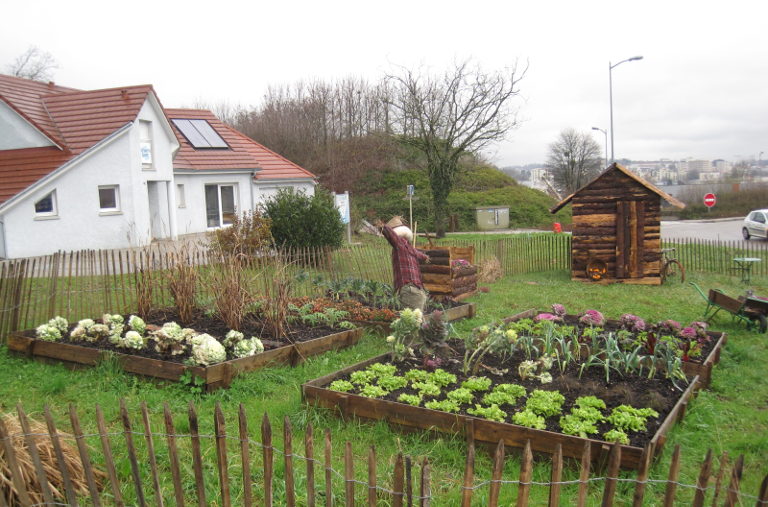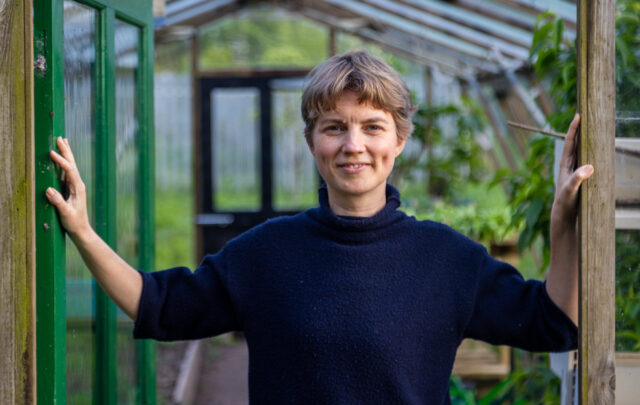May was rough! Weather.com has an almanac page showing the whole month at a glance. There were several days with highs only in the 40s (°F) and lows in the 20s. The highest temperature, 89°F, was recorded on the last day of the month; the lowest, 24°F, was just two weeks before that. The average temperature over the whole month was just under 58°F, which is definitely on the cool side.
It was also on the dry side. There was rain for the first three days of the month, and then rain fell on only three more days for the entire rest of the month. There was also that one day of snow, though I don’t count that as precipitation because the snow was horizontal and the ground remained dust dry. Officially, Vermont finished the month at about 2″ of total precipitation. This includes everything that fell out of the sky regardless of whether or not it moistened the soil. My tally in the rain gauge and in my weather journal is closer to 3/4″, less than half of what was recorded at the Burlington airport weather station.
On the other hand, there was wind nearly every day of the month, and in my journal there are whole weeks when the winds were 15-20mph every day with gusts up to 30mph regularly. Most nights we got a break from the blowing pollen and dirt, but it started before dawn and didn’t relent until after sunset most days. As a result of the yellow air, Vermont is using quite a lot of Kleenex and antihistamines.
So it was a cold, dry and inhospitable May. Not at all early summer.
Then we hit June with record highs set all over the state on June 1st. It was 92°F here, shattering the old record of 87°F set in 2013. And just as quickly, the weather up-ended itself again. It turned cloudy late in the day on Friday, June 2nd. It rained nearly half an inch overnight, which does not make up for the droughty May but does moisten the surface layers for seedlings and new transplants. What is better is that it is cool again, the clouds have remained, and there is much less wind. So water is not instantly evaporating like it was in May. The surface is staying moist. With a bit more rain it might penetrate to the deeper levels where mature roots live. But that is incumbent upon more rain. We didn’t get as much as predicted for the first storms of the month. It was supposed to rain all weekend, yet rain only fell Friday night. There is rain in the forecast, but it’s at the end of the forecast period and seems stuck there, never moving forward with the days. Moreover, in an average summer, the weather begins to dry out around the solstice and stays dry through August. It could be a wet June. We had a very wet June in 2015, and average doesn’t mean very much these days anyway. But a wet June doesn’t seem so likely that we can bank on it, and that’s all we have right now because we did not get a ‘normal’ wet spring.
I have a customer who is reporting no hay growth in her pastures. To be clear, this means there is not enough moisture to grow meadow grass in Vermont — a place that is named for green mountains. It also means no winter food for whatever dairies she usually supplies. And no income for her and no work for the people she normally employs to cut and bale the hay. She is hoping to see a wet June with maybe a cutting in August. However, she’ll have a hard time finding the labor if it’s too close to the end of the month. Seasonal labor largely comes from teens and college kids and migrant labor. The latter will be fully employed and potentially starting to head south before September. The kids go back to school in the third week of August around here, with college kids filtering out of the state even earlier.
And it’s not just the lack of rain. Those May freezes have caused havoc also. I am happy to report that the honeylocust that looms over my house seems to be recovering. I was worried when all the new growth withered with the second round of frost in as many May weeks. It looked dead for a couple weeks and is only now putting out leaves again. There were dead-looking locust trees all around town; I don’t know how many of them are turning green now. Staghorn sumac along the sides of the roads also looks brown and wilted, and that does not seem to be recovering. Similarly, I have permanent damage to several roses and I might have lost the new crabapples. They had started opening leaf buds and those froze. Now they’re all thorny sticks. I will probably get apples from the trees around my house, but I’m not sure that the old trees in the jungle will fruit this year. That is just as well for me because I can’t get to those trees anyway, though having a bounty for the squirrels to eat does take the pressure off of the trees I want to harvest.
But around Vermont there are whole orchards of trees that are like my jungle apples. Pit fruits and vineyards in the Champlain Valley were hit hardest since these warmth-loving trees and vines aren’t completely happy in this climate to begin with. But there are apple orchards and even some cherry growers who are openly worrying about a bad harvest. Since many orchard farms also depend on sugaring for spring income, 2023 is a very bad year, because with the stubborn cold and lack of afternoon sunshine to draw up the sap it was not a good year for maple sugar either.
But I’m not doing so bad. I’m doing pretty well, in fact. Meeting my own needs, anyway. Most of my garden is adapted to cold, dry conditions. I grow herbs and grassland plants because those are the plants I know and love. And really, if you like perennial flowers, there just aren’t many that grow in humid conditions. Plants that produce large colorful flowers need abundant sunshine and good airflow. Flowers may be found on the margins of woods and wetlands, but most grow in dry upland meadows or sunny prairies. Similarly, the herb plants I grow come from arid or prairie climates. There are many woodland herbs, but most are difficult to cultivate (most woodland plants generally are difficult to grow in the garden, being that they like shady woodlands, not sunny gardens…). Woodland herbs are foraging plants, and only if you have the need and the knowledge to use them. What I use as kitchen herbs are largely the semi-woody mints that are native to the rocky hills all around the Mediterranean Sea and the Middle East.
I also grow veg that is as drought-tolerant as can be. I don’t grow many tomatoes, mainly just a few for paste and even fewer for fresh eating. There are more dryland-adapted chiles than moisture-loving bell peppers in my pepper mound, and I have cut back the eggplants to just three plants grown in pots near the house that I can easily keep watered. (Though eggplant is surprisingly forgiving of dry conditions for a nightshade with large fruit…) I do have potatoes, and those do take a good bit of moisture early in the growing season, but they need somewhat drier conditions in the middle of summer to prevent rot and to stimulate the root swelling that turns into a tuber. So now that I’ve got the potato plants growing well with all this water hauling, they should be able to withstand drought. I don’t grow any greens or brassicas in the summer, and this year I may hold off on carrots until fall since the spring round was a decided failure. I grow more drying beans than pod beans and peas only in the early spring and late autumn. I don’t grow corn at all, though the kinds I favor — blue corn and flint corn — thrive in the desert and need arid, windy conditions to set seed and then dry it out for meal. Corn takes up too much space for a rather measly harvest on each plant. It’s a field crop, not something grown in the veg garden.
I do grow a lot of cucurbits, but more of the squash side of the family than the melons or cucumbers. I don’t actually see the point of cucumber aside from pickles which I love but don’t eat much because of the salt. I also love melons but don’t allot much space to them in the garden because they don’t cook or store well and one plant takes up many square feet to produce maybe two or three fruits. Even grown up a sturdy trellis — I use old wooden ladders — they take up more room than I’d like. The yield per square foot ratio goes way down in a melon patch, whereas the same space taken up by a butternut squash can produce eight to ten hefty fruits that store all winter and can be used in a variety of ways. And, of course, summer squash is the very definition of over-productive. Still, all the plants in this family are fairly tolerant of dry conditions. Those pokey hairs on the leaves are evidence of arid grassland roots in the cucurbit family tree.
All this is to say that I have a garden that can largely withstand drought, at least as it is defined in Vermont. Most of the perennials I grow do best with around 20″ of rain in a year, which is considered droughty conditions in Vermont. Many would develop rot if they lived in a more humid climate. Now, because most arid climates are also subtropical — those rings of high pressure on either side of the equatorial belt — dryland plants tend to be poorly adapted to cold. For example, the Mediterranean herb garden is decidedly unhappy in the deep cold of mountains and continental interiors, though, if you can protect them from winter, they do love the long sunny days of summer up north. However, the North American prairie runs almost to the polar circle, so there are plenty of native flowers on this continent that are both cold-tolerant and able to withstand drought.
However, these prairie plants have not been in cultivation for very long since growers have historically stuck to the imported garden plants of Eurasia and, to a lesser extent, Africa. In fact, American nurseries still grow a limited selection of plants, largely those long grown in the very unusual conditions of the English garden — a climate that rarely sees extreme temperatures in either direction and that has predominantly cloudy skies and humid conditions, thus low evaporation, but not excessive rainfall, about the same average annual precipitation as the American Midwest. Still, these English garden plants are easily grown in artificial conditions and are appealing to many people, with their ties to classic garden imagery and personal memories. So they sell well. Everyone buys roses and daylilies and hostas. Not as many people even know about agastache or penstemon though that is changing now that native gardening has been a concept for a few decades and growers have bred cultivars of North American plants that produce larger, more abundant blooms on smaller, less weedy plants. Ironically, these cultivars were largely developed in Eurasia. The new agastaches are actually labeled ‘Korean’, and the prettiest goldenrods, that staple of American meadows right across the continent, have been bred in France and Germany.
I am fortunate to have spent many years gardening in northern New Mexico, a place that is dry and sunny, but a mile and more in elevation — so therefore rather cold. I gardened in the Sandia Mountain foothills at 6400 feet. So I learned to deal with high topography, high winds, and cold nights even in the middle of summer. I had to protect the herb garden from the -20s (°F) at least once a winter, though I don’t remember temperatures colder than that and those lows were never sustained for more than a few hours. The dry season was at its worst from February to early July, so there was rarely a spring. I normally held off on planting most garden veg until late in May, though it was warm enough to grow even chiles by April. My small plots of peas and salad greens were planted in February, nurtured along with reclaimed grey-water (I kept collection buckets in the bathroom showers), and were done before the real heat took over around May Day. And I grew many North American dryland and desert natives in the perennial beds.
There were several nurseries in Albuquerque and Santa Fe that specialized in high desert gardens — since those were the only plants that would grow in the high desert of Albuquerque and Santa Fe without ridiculous levels of water use. Around the beginning of this century, New Mexican communities started penalizing garden irrigation and handing out tax incentives to those who planted xeriscapes. Being that I didn’t like grass anyway, I was an early adopter. I wiped out all but a small circle of lawn around the apple tree that came with the house (probably predated the house), filling that space with dryland buffalo grass, and then laying buried soaker hose rather than sprinklers so that the water I did add to the garden didn’t just evaporate but was delivered right to the roots. I replaced the grass with Mediterranean herbs by the back of the house, prairie and sagebrush perennials throughout the old lawn, and native trees and shrubs around the perimeter. I planted some cacti, but mostly for food. (I love prickly pear!) But I did have cholla growing in a truly intolerable Martian patch of rocky sand left over from some former owner’s ill-advised attempt to park an RV on the property.
So it was a desert garden, but it wasn’t a place of thorns and needles and jagged rock. It also wasn’t ruddy brown, but green. Usually more on the bluer side of the spectrum, but nevertheless lush with growth and filled with many, many bright flowers that drew even brighter insects and hummingbirds. (I am fluent in hummingbird swear words… which is about all they speak…) As an added benefit, many plants native to arid climates are oily, because that’s an effective way to store moisture in a land of little water, so most are highly scented. Not all good, mind you. Creosote bush every bit is as pungent as it sounds, and jimsonweed produces such a sickly sweet stench that you’re sure there must be dead bodies lying in the sun somewhere nearby. But the majority produce intoxicating fragrances. So my garden was a banquet of scent.
Being a gardener led by the nose more than the eye, I have, of course, tried to reproduce that banquet in New England. I can’t grow rosemary in large shrubs, nor can I grow most desert sages or the miraculous chocolate flower (yes, it does…). But I can grow most of the agastaches which carry a delightful scent over the entire plant, not just the flowers. With careful attention to drainage (not difficult on this hillside property even with the clay-rich soil), I can grow most of the penstemons, all of which have scented blooms. I have more options for grassland flowers here also, so I can have monarda and clovers and meadowsweet.
These are all plants that will grow, that are growing, in my Vermont garden, even in a decidedly trying growing season. There are problems here and there, but I’m not at risk of losing the farm, so to speak. No, I have a garden that literally stops traffic, especially when I’m out there working. People will stop to admire it and ask questions. So I know this is a garden that appeals to many people, not just me. I also have many people stop and ask about the food I’m growing, and my neighbor thinks I should start a horticultural school to show others how to get the most harvest out of the least work, expense and space. I don’t think that will happen. I’m rather of the opinion that that would increase my workload and substantially decrease the harvest to effort ratio. Also, it’s not necessary; the garden is out there in full view. People walk, bike and drive by it all day long, every day. They can see what is working and stop to ask about what they don’t understand. I’ve already started something of a trend in xeriscape bank planting. This year, I’ve seen more than one neighborhood household that is ripping out the weedy grass on difficult slopes and putting in poppies, sage, and echinacea mixed with locally native meadow plants like goldenrod, asters and milkweed.
More to the point, I will have a sufficient harvest, unlike those who are specializing in crops. There may be a deficiency of carrots and peas, but the garlic and onions and potatoes more than compensate. I have beauty and nutrition and have made an oasis of abundance in the middle of a cold, concrete town. And I’ve hardly begun to reclaim the jungle. Yet I don’t have to spend much effort or money on this enterprise. Oh, I might complain about the water hauling and weed pulling, but I don’t have to install irrigation nor do I have to hire landscaping labor. And I don’t work on the garden for more than an hour on most days, probably less than ten hours a week at the height of the growing season.
I think this is an ideal path toward sufficiency, one that anyone can manage. I do have more space than is available to many urbanites, but I don’t think many urban spaces are sustainable anyway. For all those places that have at least some exposed earth around the built environment (those that are free from other stresses like ocean rise and water scarcity and industrial toxicity, anyway), this is a way to feed ourselves, nurture our bodies and spirits, and regenerate living spaces. On this property that is nearly surrounded by a typically industrial New England town, I have uncounted numbers of butterflies and moths and bees and other insects and many species of birds and mammals, in addition to all these diverse plants. And that’s the key — diversity! There’s always something that will be happy and healthy and productive, no matter the extremes of weather or other stresses. There will always be a harvest — and I don’t have to spend that much time to obtain it. I can do other things. Or, in a future that requires less money, I can do nothing at all. I can sit and watch the amazing swirl of teeming life.
So May was rough, and those that are working within the capitalist system of specialized crop farming are suffering the most. There will be shortages that may ripple outwards. A lack of hay on one farm in June may mean increased milk prices in the grocery stores in September. The hay farmer may be forced to diversify if she wants to continue farming. She probably already grows a diversity of things in her kitchen garden to meet her own needs. But to insulate her farm from stresses like an unusually dry May, she needs to follow a similar growing plan in her fields as she follows in the veg patch. Or she could forgo the monetary revenue and just provide a living for herself.
That would undoubtedly cause ripples. Those other specialists who depend upon her hay would be forced to change as well. Very likely most of them would find it impractical to continue specializing and sending much of their precious harvest to market in exchange for money. It would be cheaper and more efficient to grow a diversity of things that meet their own needs directly. They may still have surplus to trade locally. They may even find that they have too much land to work themselves without expensive mechanized or hired labor, and so they may off-load many acres to others who want to work to meet their own needs as well.
Once this specialized system starts breaking down under stresses like a rough May, it may be impossible to stop the rippling waves of change. And not only because this will be economically necessary. My way of doing things is so much more desirable, so obviously pleasant, so full of beauty, abundance and life. And it never fails. That’s a hard thing to resist. If people are already planting the particular mix of wildflowers and herbs that I’ve got growing in the front bank and stopping their cars to beg my secret for growing garlic, I don’t imagine it will take long before my isolated example becomes the norm around here.
And then a rough May won’t matter so much. Maybe not even to milk prices in September. Imagine if my hay farming customer starts raising a resilient mix of pasture animals on her upland farm, animals who eat different kinds of plants, rather than the near monoculture of timothy and alfalfa that serves as hay for winter silage that goes to land-poor dairy farms. She would have a large number of potential surpluses to trade — meat, wool, leather, composted manure, and milk. Plus perhaps honey from meadow hives and fruit and other tree-crops from hedgerow trees and bushes. (Though it’s unlikely that she’d have much money.) And when she is doing all this herself, but not producing a glut of hay, other farmers will also be forced to diversify and meet their own needs. And those changes ripple on and on and on. Soon, in a region where diversity has become normalized in response to stress, there may not be specialized dairy farms sending cheap milk to grocery stores, but every farm and perhaps a large number of town-dwellers might have a dairy cow. With dairy cows that widely distributed, every person stands a good chance of knowing at least one other person who has a milk surplus to spare.
And that’s just milk. Dairy cows are far more difficult to manage than my garden of abundance. Anyone can produce a plentiful harvest with a similarly small plot of raised beds growing a wide variety of simple food plants that are adapted to many conditions. So it’s unlikely that anyone would live with the dearth that is considered normal in this system, even in years of good harvest. Nobody would have to go hungry.
Do you see how seductive this garden of diversity is?
There are many days when I am despondent about the future. I am particularly worried about all these city folk who don’t have the resources to escape. But then I think about the implications of my garden and how specialized systems will naturally progress to diversity in times of stress. Perhaps even large swathes of cities can be reclaimed, though I don’t think that will be strictly necessary if people want to leave. I don’t think everything will come up roses, but then even roses have thorns. I do think that there will be enough and more for everyone willing to embrace the changes. And, when it comes to my garden, I don’t see too many unwilling people.
And that give me a very nourishing sense of hope!
Teaser photo credit: Typical potager (French intensive gardening) with its traditional scarecrow in the French countryside. By Arnaud 25 – Own work, CC BY-SA 3.0, https://commons.wikimedia.org/w/index.php?curid=30752921





